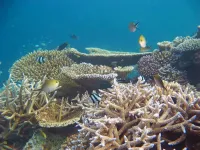INFORMATION:
Reference: 'Analysis of fine particulates from fuel burning in a reconstructed building at Çatalhöyük World Heritage Site, Turkey: assessing air pollution in prehistoric settled communities' Lisa-Marie Shillito, Anil Namdeo, Aishwarya Vikram Bapat, Helen Mackay & Scott D. Haddow, Environmental Geochemistry and Health DOI: 10/1007/s10653-021-01000-2
Prehistoric homes would have failed modern air quality tests
Domestic burning of wood and dung fuels in Neolithic homes would have exceeded internationally agreed standards for indoor air quality, exposing inhabitants to unsafe levels of particulates
2021-06-30
(Press-News.org) Domestic burning of wood and dung fuels in Neolithic homes would have exceeded modern internationally-agreed standards for indoor air quality, exposing inhabitants to unsafe levels of particulates.
Working with environmental engineers, archaeologists at Newcastle University, UK, used modern air quality monitoring methods to assess the impact of domestic fuel burning inside buildings at Çatalhöyük, in Turkey, one of the world's earliest settlements.
A typical house at Çatalhöyük, a UNESCO World Heritage site, had a domed oven set against the south wall, located beneath an opening in the roof. In the 1990s, a replica of one of these houses was built at Çatalhöyük to show visitors what they may have looked like during the time of occupation.
Although previous studies have shown that burning biofuels has significant negative consequences on health, especially in enclosed spaces with poor ventilation, the relationship between fuel use and health in prehistory has never been explored.
The research team, which included experts from Northumbria, Durham and Copenhagen universities, burned different types of fuel in the hearth of the replica house and measured pollution levels to test how living in these buildings may have exposed the inhabitants to fine particulate matter and impacted on their respiratory health.
The research, which was funded by the Wellcome Trust, found that the average levels of fine particulate matter (PM2.5) over a two hour period were extremely high and that concentrations continued to remain high up to 40 minutes after the fires had burnt out afterwards.
The results indicated greater exposure directly in front of the oven although similar levels were also detected to the side of the hearth, suggesting that a person's position in relation to the fire would have had only a minimal impact on exposure.
Dr Lisa-Marie Shillito, Senior Lecturer in Landscape Archaeology, explained: "At Çatalhöyük, the lack of a proper chimney, and the fact that buildings consist of a single, small room that combined living space and the hearth, means that anyone inside the building would have been exposed to unsafe levels of particulates as a result of everyday domestic activities. This would almost certainly have had a negative health impact on these communities, due to a combination of an open fire and lack of ventilation."
Studying air pollution and respiratory health in the past can be challenging because human remains do not always provide clear signs due to inadequate preservation. Small particles of PM2.5 can travel deep into the lungs where they become embedded in the tissue and can even enter the blood stream, triggering an inflammatory response outside the lungs. The remains of many of the inhabitants of Çatalhöyük show signs of osteoperiostitis, or bone lesions, which can be response to infection, and the research team suggest that this may be explained by the chronic exposure to PM2.5 that this community would have had.
Professor Anil Namdeo, Professor of Air Quality Management, Northumbria University, said: "This work has important implications for the current era. Many communities all around the world still use biomass for cooking and heating, and in poorly ventilated houses, resulting in more than four million deaths each year associated with indoor air pollution. Our study highlights this issue and could pave the way for developing mitigation measures to minimise this."
ELSE PRESS RELEASES FROM THIS DATE:
Reactive oxygen species (ROS): Key components in cancer therapies
2021-06-30
Reactive oxygen species (ROS) are highly reactive chemicals which contain oxygen radicals. Hypochlorous acid, peroxides, superoxide, singlet oxygen, alpha-oxygen and hydroxyl radicals are the major examples of ROS, which are familiar to persons from many walks of life as they are used in many domestic and industrial processes. ROS are naturally produced during a variety of biochemical reactions within the cell organelles such as the endoplasmic reticulum, mitochondria and peroxisomes. ROS are also formed as a byproduct of the normal metabolism of oxygen. The production of ROS can be induced by various factors such as heavy metals, tobacco, smoke, drugs, xenobiotics, pollutants and radiation. From various experimental studies, it is reported that ROS acts as either tumor suppressing or tumor ...
Ivermectin treatment in humans for reducing malaria transmission
2021-06-30
Malaria still kills millions. Researchers are excited by a new intervention: giving people a drug which kills mosquitoes that bite them. Incredibly, this is a reality, as the drug ivermectin, widely used for the control of parasite infections such as lymphatic filariasis and onchocerciasis, appears to do this. With some mosquitoes now resistant to the insecticides used in treated bed nets, this is a potentially important new control measure.
LSTM's Dr Rebecca Thomas and Dr Joseph Okebe, together with Dr de Souza from the Noguchi Memorial Institute for Medical Research (NMIMR(link is external)), University of Ghana, first examined the experimental evidence that giving the drug to people kills the mosquitoes that bite them.
All included studies showed large effects of ivermectin on ...
A future ocean that is too warm for corals might have half as many fish species
2021-06-30
Predicting the potential effects of coral loss on fish communities globally is a fundamental task, especially considering that reef fishes provide protein to millions of people. A new study led by the University of Helsinki predicts how fish diversity will respond to declines in coral diversity and shows that future coral loss might cause a more than 40% reduction in reef fish diversity globally.
Corals increasingly bleach and often die when the water warms. What happens to fish if there are no alternative reefs to swim to? The few fish species that feed on corals will inevitably starve, but the rest might find alternative rocky habitat to persist. As yet, it has been hard to ...
Detailed simulation of air flow after sneezing to study the transmission of diseases
2021-06-30
By the beginning of April 2021, the number of people infected during the COVID-19 pandemic had risen to more than 130 million people of whom more than 2.8 million died. The SARS-CoV-2 virus responsible for COVID-19 is transmitted particularly by droplets or aerosols emitted when an infected person speaks, sneezes or coughs. This is how the viruses and other pathogens spread through the environment and transmit infectious diseases when they are inhaled by someone else.
The capacity of these particles to remain suspended in the air and to spread in the environment depends largely on the size and nature of the air flow generated by the expiration of air. As with other airborne infectious diseases such as tuberculosis, common flu ...
Severe cannabis intoxication and rates of ingestion in children rise after legalization
2021-06-30
Significantly higher rates of child intensive care admissions for unintentional cannabis poisonings have been seen following legalization of the drug in Canada.
Researchers from The Hospital for Sick Children (SickKids), based in Toronto, found a four-fold increase in unintentional poisonings in children under the age of 12 and a three-fold increase in intensive care admissions for severe cannabis poisoning in the first two years following cannabis legalization.
However, the overall number of visits per month for cannabis intoxications to the SickKids Emergency Department (ED) remained consistent when comparing the pre- and post-legalization ...
NIST laser 'comb' systems now measure all primary greenhouse gases in the air
2021-06-30
Researchers at the National Institute of Standards and Technology (NIST) have upgraded their laser frequency-comb instrument to simultaneously measure three airborne greenhouse gases -- nitrous oxide, carbon dioxide and water vapor -- plus the major air pollutants ozone and carbon monoxide.
Combined with an earlier version of the system that measures methane, NIST's dual comb technology can now sense all four primary greenhouse gases, which could help in understanding and monitoring emissions of these heat-trapping gases implicated in climate change. The newest comb system can also help assess urban air quality.
These NIST instruments identify gas signatures by precisely measuring the amounts of light ...
Fecal records show Maya population affected by climate change
2021-06-30
A McGill-led study has shown that the size of the Maya population in the lowland city of Itzan (in present-day Guatemala) varied over time in response to climate change. The findings, published recently in Quaternary Science Reviews, show that both droughts and very wet periods led to important population declines.
These results are based on using a relatively new technique involving looking at stanols (organic molecules found in human and animal faecal matter) taken from the bottom of a nearby lake. Measurements of stanols were used to estimate changes in population size and to examine how they align with information about climate variability and changes in vegetation drawn from other biological and archaeological sources.
By using the technique, the researchers were able ...
Buttoned up biomolecules
2021-06-30
Increasing our understanding of cellular processes requires information about the types of biomolecules involved, their locations, and their interactions. This requires the molecules to be labeled without affecting physiological processes (bioorthogonality). This works when the markers are very quickly and selectively coupled using small molecules and "click chemistry". In the journal Angewandte Chemie, a team of researchers has now introduced a novel type of click reaction that is also suitable for living cells and organisms.
As an example, labeling biomolecules allows for the localization and characterization of tumors ...
COVID-19-mRNA vaccine induces good immune response against coronavirus variants
2021-06-30
A new Finnish study shows that 180 health care workers who had received two doses of the Pfizer and Biontech vaccine have very good antibody responses against the SARS-CoV-2 virus. The immune response was as strong against the alpha variant (formerly the UK variant) but was somewhat decreased against the beta variant (formerly the South Africa variant).
Finnish researchers from the University of Turku and University of Helsinki together with Turku University Hospital, Helsinki University Hospital, and the Finnish Institute for Health and Welfare studied the immune response induced by the coronavirus vaccinations, which started in Finland in December. The researchers analysed vaccine responses ...
Eel products in the EU and the UK need better regulation
2021-06-30
Growing in popularity, unagi kabayaki - grilled freshwater eel in soy sauce - can be found on the menu of many Japanese restaurants, and is stocked by Asian shops and in specialist supermarkets. But new research tracing the DNA of eel fillets used for this dish has found that fraudulent food labelling is rife, with a third of the products violating EU regulations on the provision of food information. With certain species of eels now endangered, the researchers say that accurate labelling on these products is vital if the global eel trade is to be sustainable.
The European eel is a critically ...
LAST 30 PRESS RELEASES:
Numbers in our sights affect how we perceive space
SIMJ announces global collaborative book project in commemoration of its 75th anniversary
Air pollution exposure and birth weight
Obstructive sleep apnea risk and mental health conditions among older adults
How talking slows eye movements behind the wheel
The Ceramic Society of Japan’s Oxoate Ceramics Research Association launches new international book project
Heart-brain connection: international study reveals the role of the vagus nerve in keeping the heart young
Researchers identify Rb1 as a predictive biomarker for a new therapeutic strategy in some breast cancers
Survey reveals ethical gaps slowing AI adoption in pediatric surgery
Stimulant ADHD medications work differently than thought
AI overestimates how smart people are, according to HSE economists
HSE researchers create genome-wide map of quadruplexes
Scientists boost cell "powerhouses" to burn more calories
Automatic label checking: The missing step in making reliable medical AI
Low daily alcohol intake linked to 50% heightened mouth cancer risk in India
American Meteorological Society announces Rick Spinrad as 2026 President-Elect
Biomass-based carbon capture spotlighted in newly released global climate webinar recording
Illuminating invisible nano pollutants: advanced bioimaging tracks the full journey of emerging nanoscale contaminants in living systems
How does age affect recovery from spinal cord injury?
Novel AI tool offers prognosis for patients with head and neck cancer
Fathers’ microplastic exposure tied to their children’s metabolic problems
Research validates laboratory model for studying high-grade serous ovarian cancer
SIR 2026 delivers transformative breakthroughs in minimally invasive medicine to improve patient care
Stem Cell Reports most downloaded papers of 2025 highlight the breadth and impact of stem cell research
Oxford-led study estimates NHS spends around 3% of its primary and secondary care budget on the health impacts of heat and cold in England
A researcher’s long quest leads to a smart composite breakthrough
Urban wild bees act as “microbial sensors” of city health.
New study finds where you live affects recovery after a hip fracture
Forecasting the impact of fully automated vehicle adoption on US road traffic injuries
Alcohol-related hospitalizations from 2016 to 2022
[Press-News.org] Prehistoric homes would have failed modern air quality testsDomestic burning of wood and dung fuels in Neolithic homes would have exceeded internationally agreed standards for indoor air quality, exposing inhabitants to unsafe levels of particulates


